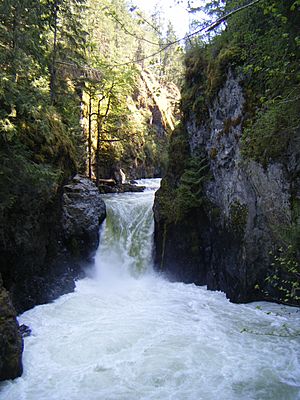Englishman River facts for kids
The Englishman River is a cool river found on the eastern side of Vancouver Island in British Columbia, Canada. It begins high up in the Beaufort Range mountains, starting from a small place called Jewel Lake. The river then flows east for about 40 kilometers (25 miles). Finally, it reaches the Strait of Georgia near the town of Parksville, British Columbia.
This river is super important! It's a "watershed," which means it collects water from a large area. It provides a home for different kinds of salmon fish. Plus, it gives drinking water to the people living in Parksville and nearby areas. Many lakes are part of the Englishman River's watershed, including Arrowsmith Lake, Hidden Lake, Fishtail Lake, Rowbotham Lake, Healy Lake, Shelton Lake, and Rhododendron Lake.
Englishman River Falls Provincial Park is a very popular spot about 10 kilometers (6 miles) upstream from where the river meets the ocean. People love to visit this park because of its two beautiful waterfalls and lovely camping spots among the trees. The park was created on December 20, 1940. It helps protect the very old trees and the natural environment around the waterfalls. A special dam on the Englishman River also helps collect water for Parksville.
Why is it Called Englishman River?
The river has been called Englishman River since at least 1883. This name remembers an unknown Englishman who sadly drowned while trying to cross the river.
The Story Behind the Name
There's a local story from the Indigenous people who lived in the area. They say they found the bones of a Caucasian man near the waterfalls. This sad event is how the river got its current name.
Long ago, Spanish mapmakers had a different name for it: "Rio de Grullas." This name probably came from the many great blue herons living where the river meets the sea. "Grulla" is the Spanish word for "crane," which is a type of bird similar to a heron.
South Englishman River Branch
The Englishman River also has a smaller branch called the South Englishman River. This part of the river starts at Shelton Lake, which is also known as Echo Lake. Soon after leaving Shelton Lake, the water flows into Healy Lake, sometimes called Panther Lake. The river then leaves Healy Lake and flows northeast. Finally, it joins up with the main part of the Englishman River.


